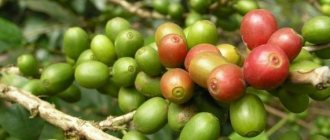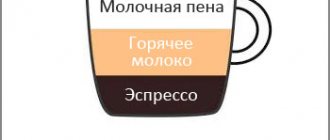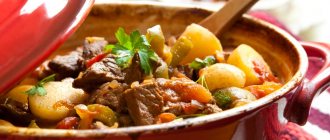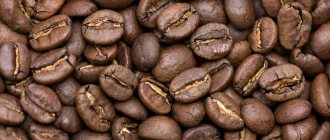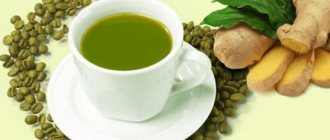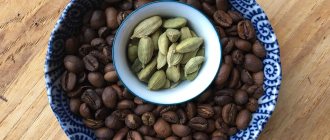Coffee drink with milk No. 130.
Name of dish: Coffee drink with milk
Technological map (culinary recipe) No. 130
Type of processing: Cooking
Recipe (layout of goods) for 100 g net dish:
Nutritional value, calorie content and chemical composition of the dish (vitamins, microelements):
Recommended yield of food for feeding babies for 1 meal (g):
Technological map for preparing a dish at a preschool educational institution:
Return to list of dishes: DRINKS
You can load this recipe into any program in the Nutrition series: first save the recipe in a file, and then load it into the program. annotation
Would you like a discount on the Kindergarten: Meals program? Find out the details here.
* Note: here, as an example, the weight of only some goods is given; all data is 100% given in the proposed program Kindergarten: Nutrition.
Recipe for a coffee drink in kindergarten.
“Mom, now in the kindergarten we were treated to a coffee drink, it’s so delicious” - the words of a satisfied lisping toddler instantly transport you to childhood. At that time, which smelled deliciously of “cock on a stick”, sweet toffee, condensed milk, and yes - coffee. We may be bad at remembering many things and actions in our heads, but the smells of those things are not bad - they are not so easy to erase from memory. We drank a coffee drink, imagining that it was real coffee, and we were the same business adults. They wanted to grow up faster, they were trusting. But this was a lyrical digression, a trick by the creator to further “immerse” the reader in the topic under consideration. Let's take a closer look at what a coffee drink is and what it is eaten with? What is its composition and does it harm our children? Let's find out!
It is not recommended to be scared; coffee in a children's coffee drink is only found in the title. There is no natural coffee in most formulations; it is usually replaced with the following components:
As can be seen from the list, the composition is even very safe.
Giving a coffee drink is allowed to children over 2 years old, the daily norm is less than 1 cup per day. If the child is not allergic to the ingredients, “surrogate” coffee (it is also called that) will not only not harm the child, but will also saturate the child’s body with the necessary vitamins and microelements. For example, chicory is able to balance the unbalanced nervous system of children, rose hips have a general strengthening effect. A coffee drink can restore the microflora of the intestinal tract, remove toxic substances (due to oligosaccharides and pectins in its composition), and improve appetite, which is especially important for “small-fed people.” The oats included in the composition contain a huge amount of protein, which is simply needed by a rapidly growing child's body, barley contains B vitamins and magnesium.
From time to time, natural coffee is included in the drink. Parents should not worry about this: firstly, the amount is usually not significant, and secondly, caffeine has an invigorating and tonic effect on the body. If consumed in moderation, it will not cause any harm to the baby’s body. But you need to know that an overdose of a drink that contains natural coffee can lead to leaching of calcium from the body (this is a property of caffeine) and provoke increased excitability. Please note that it is recommended to avoid consuming this drink in the evening.
Let's look at the nutritional characteristics given in the technological map of the drink. So, KBZHU of surrogate coffee per 100 g:
- Proteins 1.56 g,
- Fats 1.33 g,
- Carbohydrates 7.1 g,
- Calorie content 46.7 kcal.
- The card also shows vitamins (B1, B2, C) and microelements (calcium, iron).
Compound
The medicinal properties of a natural product are determined by its composition.
Nutritional value (100 ml):
- kJ - 12.6;
- kcal - 3;
- proteins - 0.2 g;
- carbohydrates - 0.1 g;
- water - 99 g.
Can children drink coffee - what are its benefits?
Consumption of natural energy drinks in appropriate quantities has a beneficial effect on the psyche, increases attention, concentration, physical and mental performance (important for teenage schoolchildren during exams). Caffeine improves mood, feeling of well-being, helps get rid of headaches
Positive effects:
cleansing the body; removing free radicals from the body; cancer prevention; support brain function (temporarily); improvement of attention, ability to remember (temporarily); calming the central nervous system; natural antidepressant; diabetes prevention; prevention of vascular and heart diseases; increased blood pressure (caution!); defecation support; improvement of metabolism; cleansing the colon as it passes through the intestines; prevention of liver diseases.
Harm, danger of coffee
In addition to the positive effects of the natural drink, it is worth mentioning the adverse effects that occur in the body (the frequency of manifestations varies from person to person).
Side effects include sleep disturbances. Caffeine reduces the quality of sleep (therefore you should drink the drink in the morning and in the first half of the day), promotes diuresis (diuretic effect), and increases blood pressure (1-2 mmHg).
Excessive consumption can cause digestive problems and abdominal pain.
addictive
The alkaloid caffeine is a pharmacologically active substance that stimulates the central nervous system. In addition to its positive effects, it is described as a “potential drug.” But restrictions on use are not determined by the responsible authorities.
The WHO concluded that there is no evidence that caffeine consumption leads to the effects that occur when taking addictive substances. The American Psychiatric Association said the substance did not meet criteria for being associated with drug addiction.
Therefore, if addiction exists, then withdrawal symptoms after cessation of use are minimal or unnoticeable.
Effect on the body
When a person drinks coffee, caffeine enters the body, is broken down into chemicals by liver enzymes, and then travels throughout the body, affecting the brain.
A substance similar to adenosine that affects the sleep-wake cycle. When adenosine combines with a sufficient number of receptors, signals are sent to the brain about the onset of sleep and rest. When drinking the drink, caffeine molecules bind to adenosine, preventing it from connecting to receptors. It does not replace the need for sleep, but relieves the feeling of fatigue and drowsiness. Therefore, there is a feeling of fresh energy.
Child's coffee debut. Book recipe
There is a first time for everything in life, and it is very important that the first impression of anything is pleasant. Do you want to give your child coffee, but are you afraid that he won't like it? We advise you to follow Max Fry's recipe and brew a magical drink with rose water. It minimizes bitterness, which can cause disgust in a child, and gives the drink a special taste.
To get rose water, you can simply infuse regular water with a few rose buds plucked from the bush. But this method is suitable if you or your neighbors are breeding roses. If this method doesn't work for you, no problem, you can make rose water from dried rose petals, which are sold in the spice department.
Simply soak the dried petals of three to six buds in clean water for several hours. In extreme cases, you can use rose syrup. Three to four spoons per small cezve is what you need.
When the rose water is ready, grind the coffee in a coffee grinder, preferably African beans. Then fill the cezve with rose water, add a couple of heaped spoons of freshly ground coffee (in this order, since dry roasting can give the drink additional bitterness) and a pinch of cinnamon (you can also try cardamom and nutmeg, but do not overuse it - the child may not like it). appreciate the taste is too rich).
Cook the drink over low heat until a high head of foam appears, remove it from the heat twice and stir, add a spoonful of cold water to the finished drink so that the grounds settle, give the child a saucer with cane sugar, which he can put in the cup without limitation, and observe the reaction. Most likely, the baby will be satisfied.
Drink to activate strength and mental activity
Coffee is truly a miraculous drink. It stimulates brain activity, improves memory, allows you to absorb more information, feel cheerful and full of energy, increases endurance and reaction speed, activates the gastrointestinal tract (if you or your baby do not have stomach problems) and simply improves mood .
Of course, you need to follow strict rules, because even an adult, excessively strong coffee in large quantities has a detrimental effect. And a student shouldn’t turn drinking coffee into an everyday ritual; it’s better to come up with a special coffee ritual that will take place once or twice a week and can turn into a real holiday.
Recipe for “activating” coffee:
We brew two teaspoons of natural coffee in a cezve, at this time we bring two teaspoons of cocoa powder, two tablespoons of brown sugar and 100 grams of milk to a homogeneous consistency.
“Mom, today in kindergarten we were treated to a coffee drink, it’s so delicious” - the words of a contented lisping toddler instantly transport you to childhood. At that time, which smelled deliciously of “cock on a stick”, sugar toffees, condensed milk, and yes - . We may have trouble remembering many things and events, but the smells are good - they are not so easy to erase from memory. We drank a coffee drink, imagining that it was real coffee, and we were those same business adults. We dreamed of growing up quickly, naive. But this was a lyrical digression, the author’s trick to further “immerse” the reader in the topic under consideration. Let's take a closer look at what a coffee drink is and what it is eaten with? What is its composition and does it harm our children? Let's find out!
Let's look at the composition
Don't be alarmed; coffee in children's coffee drinks is only in the name. There is no natural coffee in most formulations; it is usually replaced with the following components:
- Chicory;
- Rose hip;
- Barley;
- Acorns;
- Chestnuts;
As can be seen from the list, the composition is very harmless.
Giving a coffee drink to children over two years of age is allowed, the daily norm is no more than 1 cup per day. If the child is not allergic to its constituent components, “surrogate” coffee (it is also called that) will not only not harm the child, but will also saturate the child’s body with the necessary vitamins and microelements. For example, chicory is able to balance the unstable nervous system of children, rose hips have a general strengthening effect. A coffee drink can normalize the intestinal microflora, remove toxic substances (due to oligosaccharides and pectins in its composition), and improve appetite, which is especially important for those with little appetites. The oats included in the composition contain a large amount of protein, which is simply necessary for a rapidly growing child's body, barley contains B vitamins and magnesium.
Sometimes natural coffee is included in the drink. Parents should not worry about this: firstly, the amount is usually insignificant, and secondly, caffeine has an invigorating and tonic effect on the body. If consumed in moderation, it will not cause any harm to the baby’s body. But you should know that an overdose of a drink that contains natural coffee can lead to leaching of calcium from the body (this is a property of caffeine) and provoke increased excitability
Please note that you should avoid drinking this drink in the evening.
Let's consider the nutritional indicators given in the technological map of the drink. So, KBJU of surrogate coffee per 100 grams:
- Proteins 1.56 g;
- Fat 1.33 g;
- Carbohydrates 7.1 g;
- Calorie content 46.7 kcal.
- The card also shows vitamins (B1, B2, C) and microelements (calcium, iron).
Barley coffee recipe.
You need to take 3 teaspoons of barley grains (the larger the grains, the better). They should be rinsed well and dried completely. Then fry the barley in a very hot frying pan until they darken and a characteristic smell appears. Grind the finished grains in a coffee grinder, pour into a container with water (150-200 ml), bring to a boil and leave for 3-5 minutes. To improve the taste, you can add a spoonful of honey, a pinch of cinnamon or lemon to the drink.
The recipe for surrogate coffee made from acorns is worthy of special attention. The benefit of such a drink for the child’s body lies, first of all, in the prevention of rickets and scrofula. Ripe fruits selected in the fall are washed, dried, and shelled. Then the acorns, cut into small pieces, are dried in the oven for at least half an hour, crushed in a coffee grinder or blender and prepared like barley, in the manner discussed above.
Internet sources offer a very interesting alternative version of a coffee drink made from the fruits of Jerusalem artichoke (earthen pear). Tubers collected in autumn or spring must be cleaned, cut into small pieces, and pour boiling water over them for a couple of minutes. Then dry and fry in the oven or in a frying pan. Next, according to the principle described above, the Jerusalem artichoke is crushed and brewed. This drink will be useful for all children, but it is especially recommended for people with diabetes. The finished drink needs to be poured into cups and the little ones will be happy! Bon appetit!
First of all, you need to understand well that a child’s body is fundamentally different from an adult’s. In the first hours after birth, the baby is practically sterile and helpless to the influence of any harmful factors. By receiving antibodies and various biologically active substances with milk, the child’s body adapts somewhat, its protection increases, but for a long time some specific features characteristic only of young children continue to play an important role in relationships with the outside world.
One of these features is the structure and incomplete development of the functions of the gastrointestinal tract. In infants, the digestive glands of the stomach are practically undeveloped, which is why gastric juice has almost neutral acidity and can only “cope” normally with mother’s milk. In the second year of life, the activity and acidity of gastric juice increase, making greater variety possible in both food and drinks.
It must be remembered that the intestinal mucosa of a child is more permeable than that of adults. That is why the child’s body, as they say, is open to the intake of various, and often harmful, substances. In general, in pediatrics the concept of “harmful substance” goes beyond the generally accepted ones. What in normal doses is neutral or provides some benefit to an adult may lead to undesirable consequences for a child. And even at first glance, a harmless and familiar drink can be fraught with many both surprising and unpleasant surprises.
Maybe some seagull?
Tea may have been the very first prepared beverage on earth: it has been praised for thousands of years by Chinese aristocrats, Indian yogis, Japanese samurai and Tibetan monks. Tea is so popular that few people can imagine their day without it. Moreover, in recent years, many publications have appeared about the benefits of black and, in particular, green tea. Such information reduces the vigilance of even the most discerning parents: is it possible to argue with modern science and centuries-old experience? Of course not. But not in the case of small children!
The whole variety of teas is represented by black, red, white, yellow and green varieties. The color of tea does not depend on the type of tea tree, but on the processing method. Black tea goes through the full tea production cycle and is subjected to enzymatic treatment. Green tea only undergoes a small part of the processing process and is otherwise called non-enzymatic. The remaining teas are only intermediate links in the processing of green tea into black. The substances contained in tea are amazing in their diversity. There are not so many truly harmful substances in tea, but, as mentioned above, in the case of children, any potential danger should be considered as real. The main component of tea is caffeine. Of course, tea contains trace amounts of it, but its effect is insignificant only for adults. In children, caffeine from strongly brewed tea (as well as from weakly brewed tea, but consumed in large quantities) can cause the most negative symptoms.
First of all, caffeine
, being a powerful stimulant of the nervous system, affects the child’s behavior: the baby becomes nervous, excitable, and tearful. With the systematic intake of caffeine in a child's body, various sleep disorders can develop, such as insomnia and nightmares. Constant nervous excitement causes excessive consumption of energy and nutrients, which often affects the growth process.
Caffeine affects a child's heart by increasing the heart rate, causing a feeling of palpitations, which can also lead to increased anxiety, chest discomfort, and abnormal heart rhythms. It is also known that tea (caffeine) acts as a strong diuretic, which, when consumed systematically, washes away the microelements necessary for normal growth and development.
This property of caffeine is also unsafe for adults: an imbalance of potassium and sodium in the body often causes arrhythmias, and the constant leaching of calcium from the bones is a predisposing factor in the development of osteoporosis - thinning of bone tissue. In recent years, considerable attention has been paid to the effect of caffeine on the gastric mucosa: by acting on the digestive glands, caffeine increases the secretion of gastric juice - mainly hydrochloric acid, which in high concentrations can irritate the internal walls of the children's stomach, leading to early severe gastritis. Cases of poisoning from caffeine contained in tea (coffee) are also common among children. The first signs of poisoning are nausea, vomiting, diarrhea, shortness of breath, increased heart rate and frequent urination. In such cases, you should consult a doctor immediately!
Another active ingredient in tea, theophylline
, similar to caffeine and enhances its effect. During respiratory infections, theophylline can increase an already high temperature. In addition, theophylline, being a strong diuretic, removes anti-inflammatory and antipyretic drugs from the body, making them completely ineffective in fighting colds.
Many nutritionists today argue about the benefits/harms of tannins.
- tannins, which tea is so rich in.
On the one hand, tannins, when combined with caffeine in brewed tea, are converted into compounds beneficial to the body - theins
. Theines strengthen blood vessels, improve blood circulation, and enhance the positive effects of vitamin C. However, on the other hand, after brewing tea, unreacted so-called pure tannins remain, which have the property of suppressing appetite and preventing the normal absorption of food, which is so undesirable for a small organism.
But tea also has obvious advantages that cannot be ignored. Firstly, all known vitamins are present in tea, in varying quantities. B vitamins are especially widely represented, being an essential component in the development and functioning of the nervous system. But there is an obvious double-edged sword here: a high intake of B vitamins makes it difficult to absorb iron. There is a lot of vitamin C in freshly brewed tea. After some time (several hours), accordingly, the amount of vitamin C decreases to negligible. Secondly, tea is rich in minerals that regulate the functioning of the body. Potassium, calcium, magnesium are only a small part of the total range of substances. Of particular value are:
- fluorine and phosphorus are elements involved in the growth and strengthening of bones;
- zinc, which improves immunity and participates in metabolic processes;
- manganese, which normalizes the functioning of the nervous system.
Thirdly, tea contains a whole range of essential proteins, fats and carbohydrates, the amount of which, unfortunately, is not enough to perform any significant positive functions in the body. A unique feature of green tea is the presence of antioxidants, special substances that protect the body's cells from harmful factors. In high concentrations, antioxidants can really improve health, improve the condition of skin and hair, and normalize metabolism. But it is worth remembering that green tea contains slightly more caffeine than black tea, so before offering tea to your child, consider the possible risks and think about the consequences.
Black tea, lightly brewed (1/2 teaspoon per 200 ml of water) and diluted with milk, can be offered to children from the age of two
. In this case, no more than one small cup (50 ml) should be consumed per day, and no more than 3-4 cups per week. And only by the age of eight, when, as many scientists believe, all the main organs and systems have more or less formed, you can brew tea a little stronger - 1 level teaspoon per 200 ml of water - and not dilute it with milk. You only need to follow one rule: do not let your child drink tea later than 3-4 hours before bedtime. You should also not “pump up” your child with tea before leaving the house for a long time: before going to the theater or circus, shopping or traveling long distances by transport due to the diuretic effect of tea. Do not brew tea for a long time, otherwise not a single beneficial substance will reach the body, being destroyed under the influence of boiling water. It is enough to steep the tea for 2-3 minutes and then cool slightly. Some experts advise giving children tea only after the 2-3rd re-infusion. For a child, it is best to brew loose leaf tea, since bagged tea may contain sweeteners, dyes and flavors that are extremely undesirable for the child’s body.
Coffee is not for kids
The second most popular drink is coffee. Its rich aroma, rich taste and energizing effect lead many people to drink 1 to 6 cups daily. Scientists still cannot come to a consensus on the benefits or harms of coffee. But, one way or another, parents are more wary of it than tea, and rightly so.
Coffee contains more than 2,000 various substances, of which less than half have been studied. Caffeine makes up a huge proportion of the total mass of coffee.
, which was already mentioned above. However, unlike tea, the concentrations of caffeine present in coffee can be dangerous even for adults, what to say about children, in whom coffee, even the most diluted, can cause a hysterical attack, insomnia, arrhythmia or heartburn and severe abdominal pain .
But the greatest danger to a small organism is not caffeine, but a special substance - benzopyrene
. Benzopyrene is a hydrocarbon found in crude oil, in the air near congested highways and in gas stations. Its content in coffee is low, although the above facts make us think about whether it is worth excluding this drink not only from the diet of children, but also limiting its use by adults? Moreover, its strong carcinogenic potential (that is, the ability to cause the development of tumors) has long been proven. The main danger of benzopyrene is its proven effect on the development of leukemia, or blood cancer.
Of the positive components of coffee, we can only name the content of some vitamins (A, D and P) and minerals (iodine, phosphorus, magnesium, manganese). Coffee is strictly contraindicated for children: the later they start drinking it in adolescence (after 13-14 years), the better. But the modern market offers a wide selection of special diet coffee (coffee drink) that does not contain caffeine. This coffee is prepared from plants (rose hips, chicory, soy, etc.) and, in the absence of allergies to the constituent components, is absolutely safe for the baby’s health. Moreover, the herbs included in such “surrogate” coffee have a beneficial effect: they regulate intestinal flora, normalize appetite, balance the nervous system (chicory), and also increase immunity (rose hips) and improve health. The coffee drink is recommended for children aged 2 years and older. It’s not difficult to prepare: pour the “coffee” into a bowl of boiling water (100 ml) and stir. Then turn off the stove and let it brew for 2-3 minutes. Strain the resulting broth through a fine strainer into a saucepan with hot milk, add a little sugar and bring to a boil. Add one spoon of coffee powder per serving.
Cocoa
For many readers, the taste of cocoa is one of the “tastes of childhood.” And this is understandable: in almost all preschool and school institutions, cocoa is widely used as a drink. Let's find out why. Unlike tea and coffee, cocoa contains very little caffeine.
, which, if prepared correctly, will avoid adverse reactions.
Another thing is theobromine
, a substance similar in composition and action to caffeine and contained in cocoa in elevated concentrations, although not hazardous to health in general. It is because of theobromine that cocoa is not recommended for children under 3 years of age. Cocoa also contains more than 40 flavor compounds that often cause allergic reactions in allergy-prone children. Of the particularly useful substances found in cocoa:
- flavanol
is an antioxidant that helps improve the condition of capillaries and improve brain performance; - nutritional glycerides ( oleopalmitostearin, oleodistearin
) and proteins, well digestible, involved in the construction of tissues.
Cocoa is allowed from 2-3 years
, in an amount of no more than 50 ml per day and 4 cups per week.
To prepare 100 ml of cocoa, you need to bring 100 ml of milk to a boil. Then, in a separate bowl, dilute half a dessert spoon of cocoa and half a dessert spoon of sugar with hot milk to form a paste without lumps. Then bring to volume with boiled milk. Starting from 6-7 years,
the single volume of drink consumed can be increased to 100-120 ml. If you suddenly notice that your child has signs of an allergy: spots on the skin, itching, redness of the eyelids, stop drinking cocoa and find out the possibilities of its further use from your doctor.
Coffee protects cells from damage and the body from aging. How to make a healthy coffee drink
To drink or not to drink? Coffee is not a dietary product and therefore is not suitable for everyone due to health reasons. However, this does not mean that coffee is a harmful product. Moreover, coffee not only tastes good, it also has beneficial properties. The results of recent studies have found an explanation for this phenomenon, why people feel more alert after a cup of coffee. It turns out that roasted grains release hydrogen peroxide, a very powerful substance that protects cells from damage and the body from aging. That's why people feel the tonic effect.
However, coffee is beneficial only in small quantities - 1-2 cups per day. It is not for nothing that peoples who have preserved a long-standing culture of drinking this drink use special utensils for coffee - small cups.
Now let’s touch on the features of coffee that make it dangerous in the case of certain diseases. Digestion of coffee in the stomach requires a large amount of gastric juice, which is released in the first 15-20 minutes after drinking this drink.
Therefore, people with gastritis or stomach ulcers should avoid it. And the caffeine content in coffee makes it dangerous for patients with cardiovascular diseases if they consume it in large quantities.
What should people do who love coffee, are accustomed to it, but, given their health problems, cannot drink it without undesirable consequences. There is a way out - prepare a coffee drink according to an individual recipe. It will not only be tasty, but also original and healthy.
The effect of coffee and cola
Caffeine can give a good shake and invigorate the body - this is a well-known fact. But what happens if cola is mixed with coffee? Cola is an ideal complement to a coffee drink, since soda contains increased levels of sugar, that is, glucose, which is beneficial for brain activity.
The effect of drinking coffee energy drink with Pepsi comes immediately. The following sensations appear:
- clarification of consciousness;
- increased heart rate and pulse;
- increased mental activity;
- disappearance of fatigue and drowsiness;
- adrenaline production;
- increased performance.
Coffee and cola will give the body a lot of energy
Who can take energy drink?
It is recommended not to drink energy drinks with coffee unless absolutely necessary. It is better to drink this drink in especially emergency cases. People and situations in which drinking coffee energy drink with Pepsi is possible and beneficial:
- Night shift workers, especially those with mechanical and routine work. When you constantly need to monitor cameras and answer monotonous calls. This drink will be a salvation for workers unloading or engaged in other physical activities at night.
- Students, especially during exams. Constant cramming and preparation for the session is exhausting. Constant stimulation of mental activity is necessary. Coffee with cola is an excellent substitute for expensive ready-made energy drinks for students who are always strapped for cash.
- Athletes. Consuming an energy drink immediately before training increases endurance and effectiveness of the workout. This drink, in addition to athletes, is suitable for ordinary people who periodically play sports.
- Active people leading nightlife. After a long day of work, sometimes you want to take your mind off your problems and have fun with friends. You just need to rest after a stormy night the next day.
- Drivers. A night trip can be fatal, so you need to quickly eliminate drowsiness and cheer up.
Just don’t drink the drink often, as it has many contraindications.
Contraindications
Despite the positive feature, such as giving a feeling of vigor and fullness of strength, Pepsi with coffee, like any other energy drinks, has a number of contraindications. For some categories of people, drinking this drink can be especially dangerous.
Persons who are contraindicated from drinking coffee energy drinks with cola:
- pregnant women;
- women who are breastfeeding;
- small children and adolescents under 14 years of age;
- having diseases of the cardiovascular system;
- people with allergies or individual intolerance to certain ingredients of the drink;
- having kidney problems;
- people with nervous system disorders.
The drink has a number of contraindications
Even in the absence of these contraindications, a person may feel unwell after drinking the drink. The following effects may occur:
- cardiopalmus;
- dizziness;
- visual impairment;
- nausea;
- frequent urination;
- disorders of the gastrointestinal tract.
If these ailments do not go away after 2 hours, you should consult a doctor.
Coffee grounds as fertilizer for your plants
Drying coffee residues
Dried coffee grounds, as fertilizer for plants or for compost, are often used by experienced gardeners, but they should be used in moderation, since coffee grounds contain a pH that is too acidic and phyto-inhibitors, which interferes with plant growth.
Collect coffee residues in a container and dry them until completely dry, otherwise mold will form from wet lumps.
Dry the coffee grounds thoroughly before using them.
During sowing, you need to ensure that the layer of coffee grounds that you spread at the foot of the seedlings is thin and evenly scattered, since there is a high probability that the grounds will begin to mold and it will be difficult for the seedlings to germinate under the coffee crust.
How to make a healthy coffee drink
Rye coffee.
Wash the rye, dry it and fry it in a frying pan (do not overcook it), grind it in a coffee grinder, and brew it like coffee, you can only increase the dose - 2-3 tsp. for 150 g of water.
Jerusalem artichoke coffee.
Wash the Jerusalem artichoke tubers, dry them, cut them into small cubes and dry them in the fresh air for 3-4 days, then dry them in the oven until they turn brown. Store in a dry place. Before use, fry in a frying pan, grind in a coffee grinder and brew like regular coffee.
Sunflower seed coffee.
To 100 g of coffee beans add 100 g of sunflower seeds, fried in a frying pan and crushed in a coffee grinder.
Chicory coffee.
Nature has given us a plant, the drink from which resembles the taste of natural coffee and is not just harmless, but, on the contrary, healing. Lovers of natural coffee can be advised to add chicory to it - and its harmful effects will be significantly reduced. In the past, natural coffee was sold pre-flavored with chicory. Yes, there was pure chicory coffee. Among many nations, in particular the Germans and the Baltic states, chicory coffee is always held in high esteem.
The entire plant is used for medicinal purposes. The roots contain the bitter extractive substance chicorin, inulin, choline, highly soluble in water, proteins, fats, pectin, vitamins C, B1, E, fat, gum, essential oil, resin, tannins, mineral salts and a large number of trace elements.
Chicory preparations have antimicrobial, anti-inflammatory, choleretic, diuretic, sedative, astringent and appetite-stimulating effects. They have a regulating effect on metabolism, somewhat increase cardiac activity and reduce sweating.
A decoction or tincture of the root is used for gastritis, colitis, enterocolitis, liver disease, scurvy, hysteria, dropsy, hemoptysis, constipation, gout, spasmophilia, joint diseases, hypochondria, muscle pain, toothache, gall bladder and kidney diseases, gallstones and kidney stones, to improve digestion, eliminate discomfort in the gastrointestinal tract, liver and spleen, increase appetite, reduce sugar in urine, reduce increased nervous excitability, as a general tonic, for edema of cardiac origin, for diarrhea (even bloody ), diabetes. An infusion of flowers is used as a sedative for disorders of the central nervous system. Fresh juice of the stems is prescribed for anemia.
Hot and aromatic, strong or completely decaffeinated, with spices or cream – coffee is always popular all over the world. This amazing drink can invigorate you in the morning, make the perfect accompaniment to a fresh croissant for lunch and make the evening feel homey. Rarely does an adult deny himself a cup of coffee, but is it worth introducing a child to it? Let's figure out at what age a son or daughter can be introduced to this drink and how best to brew it.
Applicable standards
The menu in a preschool institution is developed in accordance with the physiological needs of children corresponding to their age.
The menu is approved by the head of the preschool institution for a period of at least 14 days.
The range of products included in the menu should be based on the national and territorial nutritional characteristics of children and their health.
The meal plan should include breakfasts, lunches, afternoon snacks and dinners.
Breakfast should include :
- Hot dish;
- Sandwiches;
- Hot drink.
In the event that a product is missing, it is allowed to replace it with an equivalent one.
Lunch should consist of:
- Snacks;
- Hot dish;
- Second course;
- Drinks.
The afternoon snack consists of:
- Drink;
- Bakery or confectionery product.
Dinner consists of:
To compile your daily diet you should use :
- Meat and fish products;
- Chicken eggs (served boiled or as an omelet);
- Dairy products;
- Products containing edible fats (vegetable oils and butter);
- Confectionery products;
- Vegetable products;
- Fruits;
- Canned food;
- Juices and drinks;
- Bread;
- Salt.
Fact No. 6. About the soluble stimulant
Instant coffee (like many instant products) appeared thanks to the military. They struggled for a long time to ensure that soldiers’ rations included an inexpensive but effective stimulant. At one time, fighters tested compressed tea tablets, but they did not give a noticeable effect. Then pharmacists came to the rescue and offered a new type of coffee - roasted ground beans, pressed into plates and coated with sugar. Alas, the product did not take root in the harsh conditions of army life. After much research, instant coffee as we know it has finally arrived. The technology for its production is quite simple: the grains are fried, crushed and treated with hot water to obtain an extract. It is either dried (coffee powder and granules) or frozen and then vacuum dried (freeze-dried coffee).
What is a substitute for coffee?
Coffee drinks for children use surrogates that taste similar to coffee. Most often, such products are made based on the following components:
These ingredients are thoroughly crushed and fried. They taste good and are absolutely safe for children's health.
On store shelves you can find ready-made coffee drinks made from barley and chicory. The most popular brands are “Morning”, “Evening”, “Golden Ear”, “Aroma”, “Summer”. They contain exclusively natural ingredients.
Methods for making coffee drink
It’s easy to prepare, below is a traditional recipe borrowed from the Internet (the dose is calculated for one serving of the drink):
- Coffee drink 4-5 g,
- Pasteurized milk 50 g,
- Drinking water 50-60 g,
- Granulated sugar 5 gr
- Place the drink in boiling water and bring to a boil. Then you need to let it sit (5 minutes is enough), strain, add hot milk, sugar and boil.
It is not at all necessary to take a ready-made coffee drink; it can be quickly and easily prepared without the help of others.
You need to take 3 teaspoons of barley grains (the larger the grains, the better). It is recommended to wash them thoroughly and dry them completely. Then fry the barley in a very hot frying pan until they darken and the appropriate smell appears. Grind the finished grains in a coffee grinder, pour into a container with water (150-200 ml), bring to a boil and leave for 3-5 minutes. To improve the taste, you can add a spoonful of honey, a pinch of cinnamon or lemon to the drink.
The recipe for surrogate coffee made from acorns is worthy of special attention. The usefulness of such a drink for the child’s body lies, firstly, in the prevention of rickets and scrofula. Ripe fruits selected for autumn are washed, dried, and removed from the shell. Then the acorns, cut into small pieces, are dried in the oven for more than half an hour, crushed in a coffee grinder or blender and prepared like barley, using the method discussed above.
Web sources offer a very interesting alternative to a coffee drink made from the fruit of Jerusalem artichoke (earth pear). Tubers collected in autumn or spring need to be peeled, cut into small pieces, and pour boiling water over them for a few minutes. Then dry and fry in the oven or in a frying pan. Then, according to the principle described a little higher, the Jerusalem artichoke is crushed and boiled. This drink will be useful for all children, but it is especially recommended for those with diabetes. The finished drink needs to be poured into cups and amuse the little ones! Bon appetit!
How to prepare a coffee drink in kindergarten.
1. Savory KEFIR DUMPS INGREDIENTS: ? 1.5 tbsp flour? 1 tbsp kefir? 1 testicle? 3 tbsp. spoons of butter? 2-3 tbsp. l. Sahara? 1/3 teaspoon of soda? 1/4 teaspoon salt? vegetable oil.
Ingredients: Cottage cheese – 500 g. Eggs – 5 pcs. Butter or margarine – 50 g. Raisins – to taste. Zest – from 1 lemon. Semolina – 1 tbsp. spoon with a small pile. Sugar – 100 g. Sour cream – 50 g.
A simple and delicious cupcake without flour or sugar. Now this is the only way I prepare cupcakes! A 3-ingredient recipe that has no analogues... A simple and delicious cake without flour and sugar is my favorite dessert.
Ingredients: 500 g chicken fillet, 300 g all mushrooms (we have champignons), 70 g cheese, 3 tbsp. spoons of cream, 1 onion, salt, pepper to taste. Cut the mushrooms into cubes and fry in vegetable oil with chopped onion, add salt at the end.
This recipe has been tested for years - the best homemade bread I've ever tried! Ingredients: - 650 ml warm water - 2.5 tsp. dry yeast - 1 tsp. sugar - 2 tsp. salt - 1.
Drinks based on kindergarten recipes.
What do kids usually drink in kindergarten?! That's right: milk! And also cocoa, vitamin tea and even coffee for breakfast. Now we will look into the kitchen of a preschool educational institution to learn how to prepare the right children's drinks.
In addition to water, it is very important for children to learn to drink other healthy drinks. Kvass or gas-water are not included in this list. But juice, cocoa with milk and a coffee drink are very often on the kindergarten menu.
In kindergartens in the Urals, Siberia and the Far East, children are also given vitamin tea for the second breakfast. It is prepared from rose hips. And it has long been clear that this is a record holder and a good supplier of vitamin C to our body. This is the tea we will learn to brew correctly. Well, as for cocoa and coffee, I think anyone can make it. I’ll just show you the technology cards for their production.
Total cooking time – 8 hours 0 minutes Active cooking time – 0 hours 15 minutes Price – very economical Calories per 100 g – 7 kcal Number of servings – 5 servings
Barley coffee recipe
Preparing a coffee drink based on a purchased extract is optional. There is a simple and affordable recipe that is easy to implement at home.
For the drink you need to take 3 tbsp. spoons of barley grain. It is recommended to take the largest, undamaged grains without chips or mold stains. They must be thoroughly rinsed under running water and dried. The grain is then roasted in a very hot pan for 5-7 minutes or until the grain has darkened sufficiently. After cooling, the barley is ground in a coffee grinder and a “coffee” drink is prepared in the traditional way. To do this, the resulting powder is brewed with 200-250 grams of boiling water and simmered for 3-5 minutes. To improve the taste, honey, sugar, and cinnamon are added.
If the taste of pure grain seems unpleasant to your child, you can experiment with additional ingredients. These may include dried rose hips, roasted soybeans or acorns.
Acorns should be collected in late autumn, when they are fully ripe. The fruits are washed, dried and cleared of rough skin. After this, the kernel is crushed and lightly fried. Acorn coffee is an excellent preventative against scrofula or rickets.
Attention! Dried rose hips have a strong diuretic effect, so its use is contraindicated in large quantities.
Chicory root can be successfully replaced with Jerusalem artichoke tubers collected in early spring or late autumn. During this period they contain the greatest amount of useful substances.
Negative effects of caffeine on the child's body
The alkaloid caffeine has both positive and negative stimulating effects on the nervous system. It can increase mental and physical activity, relieve fatigue, and reduce drowsiness. But in large doses it causes depletion of nerve cells. Its effect on the body depends on the type of higher nervous activity, so the dosage of products containing caffeine should be selected individually.
Effects of coffee on the nervous system
Caffeine affects the neurohormone responsible for sleepiness. Thus, it improves the reaction. Increased activity after a cup of hot drink is explained by the fact that caffeine increases blood glucose levels. In addition, it increases the production of two more hormones - adrenaline and dopamine. Adrenaline stimulates the functioning of all organs and systems of the body, but in addition to a surge of strength, it also causes cardiac disturbances and improves mood, but at the same time causes problems with sleep and makes a person easily excitable.
Which of the listed “bonuses” do children need, whose energy is already in full swing? Any mother knows how overexcitement and insomnia exhaust a child. This applies not only to children, but also to adolescents 14 years old, whose nervous system continues to develop.
Removes calcium and disrupts sleep
Not all coffee lovers know that their favorite drink has a fairly strong diuretic effect. The same caffeine is to blame. And due to frequent urination, not only dehydration occurs in the body, but also accelerates the leaching of calcium. It is known that for every 100 mg of caffeine, a person loses 6 mg of calcium. And the lack of this microelement in the baby’s body can lead to disruption of bone formation, slower growth and the occurrence of defects. In addition to calcium, other minerals and vitamins important for the development of a small person are washed away.
Due to the specific effect of caffeine on the nervous system, the child’s sleep is disrupted: he falls asleep more difficult and slower, and often wakes up in the middle of the night.
Addictive
Caffeine affects the reward center in the brain, stimulates the production of dopamine, and also has a bright taste and pleasant aroma. Even adults easily fall into these “traps,” not to mention children, who very quickly get used to the insidious drink and constantly need a new portion. Without receiving the usual cup, the baby will become irritable, capricious and absent-minded, and will feel tired and overwhelmed. Teenagers addicted to coffee are more likely to become addicted to nicotine and alcohol.
The benefits and harms of caffeine
Caffeine is a natural stimulant whose compounds have a positive effect on the functioning of the brain and central nervous system, blocks fatigue and is therefore popular among people.
Products containing caffeine: tea, coffee, cocoa, Coca-Cola, energy drinks, chocolate.
Benefits of caffeine
- Oddly enough, caffeine is useful for those struggling with excess weight because it speeds up metabolism.
- Coffee contains enough antioxidants to fight free radicals in the body.
Ingredients:
| Brewer's yeast | 10 gr. |
| Sugar | 10 gr. |
| Boiled water | 100 gr. |
Take yeast and sugar and grind them thoroughly. Then add 100 ml of boiled water (warm) and put it in a warm place so that the drink begins to ferment.
The yeast drink recipe we offer is served immediately after preparation. The presence of white foam on the surface of the drink will indicate that the yeast has already begun to work and has maximum benefits for the body.
There are many recipes for this wonderful drink; for example, you can prepare it based on yeast and sugar with the addition of honey and lemon. The taste of the drink can also be changed based on your preferences, for example, by adding a pinch of cinnamon.
This drink is drunk when overtired, as well as to prevent colds. It improves vision, hair and skin condition.
Note :
Drinking yeast drink is contraindicated for people with increased gastric secretion, kidney disease and gout. If the functioning of the liver and biliary tract is impaired, the drink can be included in the diet in small quantities. Consult your doctor before use.
Yeast is prescribed orally: for various infectious diseases, furunculosis, diabetes, skin diseases, gastrointestinal diseases, and also for the purpose of disinfecting the vagina. It has been established that liquid brewer's yeast is a strong stimulant of the secretion of gastric glands, improves pancreatic secretion and secretion of intestinal glands, and improves the absorption capacity of the small intestine.
Beneficial effects of brewer's yeast: improved appetite and well-being, weight gain, normalization of gastric secretions, improved motor function of the gastrointestinal tract, increased tone.
Symptoms of yeast intolerance: belching, a feeling of heaviness in the epigastric region, bloating, and sometimes diarrhea. To avoid this, you must first strengthen the digestive tract with vegetable juices, and then, on an empty stomach, drink a little in the morning. After this, eat only when you feel hungry. If these conditions are not met, intolerance occurs.
Contraindications: kidney disease, gout, etc. I would like to note on my own that if the kidneys are normal, then the yeast, on the contrary, supports them, the urine is filtered much better after taking brewer's yeast.
Expert opinion: “Don’t forbid your child coffee!”
Parenting forums are replete with the most contradictory information: some say that coffee poses a serious danger to children, others advise coffee in small doses because it contains a lot of beneficial properties, and others call for both adults and children to give up caffeine altogether.
According to doctors, there is no need to go to extremes - everything is good in moderation. Pavel Pronichev, general practitioner: “Coffee itself is not harmful to children. The caffeine contained in the drink, of course, excites them and irritates the stomach, but the content of this substance is much higher, for example, in green tea. Therefore, there is nothing wrong with a small cup of weak natural (but not instant) coffee diluted with cream or milk. Soviet pediatrics did not prohibit coffee in children's diets, but did not recommend it either. My eldest son, who is 8 years old, sometimes drinks weak brewed coffee with sugar and milk. If your child is already in school and shows interest in an "adult" morning drink, don't stop him from drinking it. Let him try for his health!”
Coffee drink for children
A revelation for coffee lovers will be the fact that the coffee drink that children receive in kindergarten has nothing to do with the generally accepted varieties of coffee (glazed, Americano, espresso, latte, etc.) and even less so with caffeine.
The harm of a coffee drink lies in the sugar content, because a child will refuse to drink unsweetened drinks. Sugar is a high-calorie product that harms children’s bodies: it disrupts the absorption of calcium and iron, causes hyperactivity and sleep disturbances, and causes dental caries. In addition, sugar is addictive, which can lead to weight problems in the future.
At the same time, the coffee drink is more beneficial for the child’s body than harmful. It contains:
- oligosaccharides that form favorable intestinal flora;
- pectin, which promotes rapid elimination of toxins;
- proteins, vitamin B, magnesium and biotin.
However, it is advisable for parents to pay close attention to the amount of tea consumed, since 150 ml of the product contains 20-50 mg of caffeine. It is not recommended to offer coffee drinks to children under two years of age, as this can cause problems with sleep and a weak stomach.
The daily intake is 250 ml per day.
Five main coffee substitute options
For many people, coffee is an integral part of everyday life, which is why children, looking at their parents, follow their example. If you want to limit your consumption or avoid coffee altogether, you can resort to alternative options.
Cocoa
Probably the most ideal option among coffee substitutes for a child is cocoa. In addition to being delicious, cocoa is also very healthy. When consuming cocoa, the child receives a full range of vitamins and minerals. Cocoa synthesizes endorphins and improves mood. Very popular with children and can satisfy hunger. According to established standards, children under 5 years of age should not exceed 50 ml of cocoa daily intake, and should not be consumed every day.
Barley coffee
Despite its name, barley coffee is not always made from barley. In fact, this is the general name for coffee drinks for those who lead a healthy lifestyle. Such drinks are made from barley, chestnuts, wheat and grains. It contains many useful vitamins and minerals. Barley coffee is completely acceptable for a child and can even be beneficial, since it contains absolutely no caffeine. It is recommended to cook it with milk or with the addition of condensed milk.
Acorn coffee
Acorn coffee is considered one of the best coffee substitutes. Due to the fact that acorns contain a huge amount of vitamins and minerals, this type of coffee becomes very healthy. Acorn coffee has no strict restrictions and is therefore not contraindicated for children. However, it is worth remembering that if you make this coffee yourself, it is not recommended to give it to children under 3 years of age, since if not processed correctly, a lot of toxic substances remain in the acorns.
Coffee chicory
Chicory drink is made from the roots of the flower. The roots are cut into small pieces, dried and then fried. The juice contained in the roots caramelizes when roasted and imparts a coffee flavor. It is not recommended to give chicory coffee to children under 3 years of age. Despite its huge list of beneficial vitamins and minerals, the drink causes allergies. Recently, chicory can be seen more and more often in kindergartens. These so-called preventive measures are aimed at protecting the gastrointestinal tract and reducing excess weight in children.
Coffee with lupine
Lupine is a versatile plant - in addition to milk and meat substitutes, it can also be used to make coffee. Lupine coffee is very aromatic and has a similar taste to coffee beans.
Drink to activate strength and mental activity
Coffee is truly a miraculous drink. It stimulates brain activity, improves memory, allows you to absorb more information, feel cheerful and full of energy, increases endurance and reaction speed, activates the gastrointestinal tract (if you or your baby do not have stomach problems) and simply improves mood .
Of course, you need to follow strict rules, because even an adult, excessively strong coffee in large quantities has a detrimental effect. And a student shouldn’t turn drinking coffee into an everyday ritual; it’s better to come up with a special coffee ritual that will take place once or twice a week and can turn into a real holiday.
Recipe for “activating” coffee:
We brew two teaspoons of natural coffee in a cezve, at this time we bring two teaspoons of cocoa powder, two tablespoons of brown sugar and 100 grams of milk to a homogeneous consistency.
Coffee is an insidious drink that, while helping to cheer us up, raises blood pressure, causes headaches and insomnia if consumed frequently. It is not recommended to drink coffee more than 2 times a day for adults, let alone children. Until the age of 14, this drink should not be in the diet of the younger generation. Not long ago we wrote about tea for children. It's time to talk about coffee and its substitutes for our kids.
Because Since coffee is contraindicated for children due to its caffeine content, alternatives must be sought. Some mothers wonder why do this, because there is a large selection of other safe and healthy drinks. The fact is that sooner or later, acquaintance with coffee will happen. Instead of banning this drink, it is better to introduce its surrogate, accustoming it to the taste.
The modern food industry offers a wide variety of coffee substitutes for children.
Coffee drink:
This coffee does not contain caffeine, but contains plants (soy, rose hips, chicory). These herbs are very beneficial for the baby’s health: they help regulate intestinal flora, improve appetite, increase immunity and calm the nervous system. The chicory drink is enriched with vitamins B, A, C and D. Another option is a drink with barley. In addition to a large number of useful substances, this drink has a diuretic and tonic effect. A barley drink is especially recommended in order to normalize hormonal balance, water-salt metabolism and blood circulation. Barley drink also helps prevent breast diseases. These coffee substitutes can be given to children from two years of age.
Photo from the site www.TelPics.ru
Cooking method:
Pour the coffee drink into boiling water and stir. Let sit for a few minutes. You can add milk and sugar.
Varieties of coffee drinks: barley, barley-rye, barley-chicory, barley-rye with chicory
How to choose a drink: The most important things are written on the packaging, so you need to study it carefully. There are often cases when, along with herbs, a small percentage of natural coffee is also included in the composition.
In this case, the packaging states how much caffeine it contains. Even if there is a small amount of an invigorating substance, it is still better to refuse it.
You can find Belarusian fortified coffee drinks on store shelves. All raw materials are natural and manufactured in our country. Coffee substitutes are made by mixing rye, oats and barley beans. These drinks are a source of vitamins - B7, C, B5, E, B6, B2, B1, B12, etc.
Photo from the site www.coopinhal.ru
You can make coffee for children yourself. The aromatic drink is made from Jerusalem artichoke, tubers of the earthen pear. If you dig up the tubers in the fall, they can be used all year for making drinks. You just need to peel the tubers, cut into pieces, place in boiling water for 3 minutes, and then dry in the oven. After this, the Jerusalem artichoke needs to be ground in a coffee grinder. The composition is ready to use! This drink will be especially useful for children who suffer from diabetes.
If your baby doesn’t like all the coffee substitute options, then offer him cocoa. The taste of chocolate has never left anyone indifferent. This drink, of course, contains fewer nutrients than natural substitutes, but all children like cocoa.
Why children should not drink natural coffee
Coffee negatively affects a child's well-being.
The main component of coffee, caffeine, is a powerful stimulant. When consuming an extracted coffee drink from natural beans, it enters the body in significant quantities.
From coffee, a baby can become nervous, whiny, and easily excited by any minor event. The systematic intake of caffeine into a fragile body develops persistent sleep disturbances. Nervous excitement is extremely dangerous due to excessive consumption of energy, and therefore nutrients. Thus, coffee consumption at an early age leads to delayed physical development and disturbances in the normal mental state, including:
- Violation of salt metabolism. As a strong diuretic, caffeine promotes frequent urination, which in turn flushes a large amount of beneficial substances from the body.
- Heart rhythm failure. Caffeine can cause arrhythmia. This condition causes chest discomfort or pain.
- Increased secretion of gastric juice and the development of early gastritis.
What can replace coffee for children?
Against the background of such a picture, the answer to the question “what do they give children in kindergarten?” becomes obvious. Children receive a surrogate, or coffee substitute. The drink contains natural ingredients of plant origin - barley, chicory, acorns, soy. All ingredients go well together and taste great individually. In most cases, the products are fried and finely chopped before consumption.
In the store you can find ready-made powder surrogates. Their recipes were developed in distant socialist times and still remain unchanged. All components are absolutely safe, because completely natural. You can purchase the extract in retail chains (less often in a supermarket). The following names will appear on the packaging:
- "Morning". Barley-rye mixture with a small part of chicory;
- "Evening". Exclusively roasted barley grain;
- "Fragrance." Drink made from roasted barley and chicory;
- “Golden Ear”, “Summer”. Chicory and barley in equal parts.
It is better for children to replace coffee with chicory
